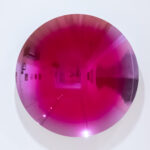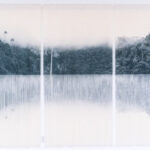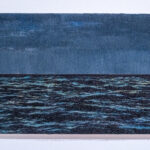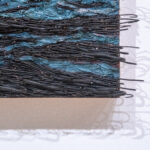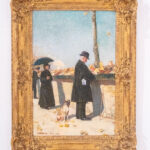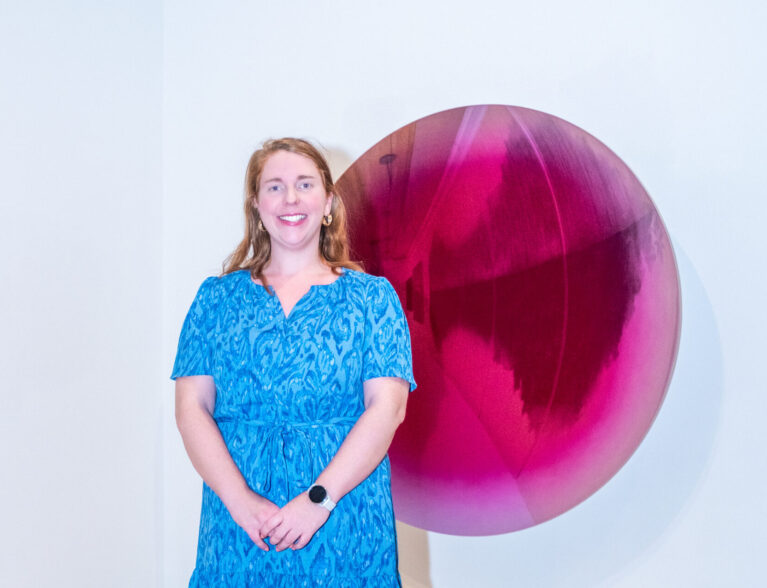
Members of the Vero Beach Museum of Art Athena Society, a top-tier group that has grown to a record 148 households, voted to purchase a remarkable, innovative piece at their annual dinner.
The decision was made to acquire “Magenta, 2020,” a mesmerizing stainless steel and lacquer sculpture by British-Indian artist Anish Kapoor. The compelling concave sculpture, measuring 63-by-63-by-9 5/8 inches, offers the viewer a range of experiences, including a slight dizziness for some.
The sculpture was one of five works offered to the Athena Society, says Caitlin Swindell VBMA chief curator. Earlier this year, she had selected about 20 works and then, joined by the collections committee, narrowed the choices down to four contemporary works and one 19th century painting.
Although pieces are always on view prior to the dinner, she opted this time to have them installed side by side, and all for the exact same three-week period.
“The big question that always comes up with the Athena works is, is it helping to fill in a gap, or is it building on an existing strength?” Swindell says.
The Magenta sculpture definitely fills a gap; it is unlike anything in the permanent collection.
Kapoor, a Turner Prize-winning artist who was also knighted for his contributions to the visual arts, is well-known for his monumental sculpture Cloud Gate, aka “The Bean.” Located in Chicago’s Millennium Park, it is one of the world’s largest permanent outdoor art installations.
“His sculptures are really a feat of architecture and use of materials. This is a concave mirror but all his most well-known works have that reflective component; they’re concave and convex mirrors. They have this element of deeply saturated color and reflective surface,” Swindell explains.
“And that’s very important to the artist. He views the sculpture as incomplete without a viewer. So for him, and why I think his work is so significant, is the viewer completes the work. We don’t have anything in the collection right now where that is the case. We also don’t have any reflective surfaces where the visitor is truly, literally, reflected in the piece.”
Swindell comments on Kapoor’s incredible talent to work with colors, explaining that red, blue and black are most significant to him for their symbolic meaning and the way he wishes viewers to experience color.
“‘Magenta’ is really a combination of the meaning of the red and blue; on the color spectrum, it’s between those. This is magenta, a color that is not perceivable on the visible light spectrum. So your brain makes up what magenta is. But in many ways it joins the themes of red and blue,” says Swindell, adding that Kapoor feels red represents blood and the body.
“Color and how the viewer experiences the work is really significant. So in addition to red, blue is like spirituality, calmness; counter in some ways to red. I mean it’s a stunning work; very, very saturated,” Swindell adds.
Although not chosen, the four other works were equally compelling.
From Cuban artist Yoan Capote was a fascinating 43 ¼-by-70 7/8-by-4-inch mixed media piece titled “Isla (antes que anochezca) [Island, Before Night Falls], 2024.”
“This is a part of his Islas series, islands in Spanish, and it is paint, nails and fishhooks, thousands of fishhooks, that create this textured wave,” says Swindell. She points out that the fishhooks only become visible close up.
“I was excited about it because we don’t have very many works in the collection that are mixed media. We have mixed media in terms of collage and paint on canvas, but just a handful that have something like a found material.”
At first glance it appears as a dark, ominous seascape, but she points out elements of hope and optimism with gestures of light and a hint of pink in the sky.
“I think that as a Cuban artist, there’s a lot of connection to his homeland. But he also views these works as being applicable to everyone in terms of broader themes about the ocean,” says Swindell.
“It’s this beautiful but perilous place. The fishhooks can give us sustenance from fishing, but there’s this danger and this end of life to it as well. And, of course, migration is a larger theme for this work.”
“Mermaid Cove, 2022,” a 60-by-80-inch oil on linen by American artist Bo Bartlett, is a lovely example of his large-scale realist artwork. Painted off the coast of Maine, his wife was the model for the woman seen looking out at the viewer.
“But that is not meant to represent her. She’s appeared throughout a lot of his works, which are narrative figurative painting in this American regionalism tradition. He was trained by Wyeth. He’s very influenced by other earlier American art,” says Swindell.
“Often there’s some sort of uncanny element or something a little bit unexpected in some of his work. Sometimes it’s a bit more overt than others; he is a masterful painter. There are instances where there’s a bit of rougher brushstrokes, which is another interesting aspect of his work.”
Swindell indicates that there is a slight ambiguous narrative to the piece, particularly with the boat.
“He is careful with how he does every detail. So are they on a sandbar or are they fleeing for some exciting reason, or is it this allure of the mermaid cove which, as a title, suggests some sort of fantastical idea?”
In this and other more recent works, she says, he begins with a pink base paint, giving the painting a warm, luminous effect. Also unique, his signature is his own red thumbprint.
“Quimbaya (Sacred House), 2024,” by Colombian artist Ana González, was another remarkable option. A sublimated photograph on roughened tarp, there are five equal-size panels spanning 97 5/8-by-244 1/16 inches in total.
González inverted her photograph at the horizontal center to create a mirror image, like a reflection. She then painstakingly unraveled each horizontal thread of the tarp from the center on down, leaving a sort of fringe that presents a gossamer version of the image.
“A lot of her work is a close look into the flora and fauna of the Amazon and of her native country. She’s done a lot of work with different indigenous communities and she’s gained access to some specific areas of landscape that not many people can access. So this is a cloud forest in this mountainous region,” says Swindell.
“And then the color that she uses is the same green that the American dollar bill is printed with. So she’s exploring this idea of nature as like a commodity, but also this meditative sacred place. There’s this beauty, but it’s also a resource that people have commodified.”
The fifth choice was “Quai Book Stalls (Booksellers by the Seine), 1888,” a framed 37 ½-by-28-inch oil on canvas by Childe Hassam, who Swindell calls one of the most well-known of the American impressionists.
With its impressionist brushwork, she says, the painting is a cornerstone work for that period of art.
“He was in Paris for three years, and this booksellers by the Seine scene is quintessential Parisian life. This was such an important place for literature and engaging with other people right in the city; like a key focus point,” says Swindell.
“I’m always interested in the differences between American and French impressionism. Some scholars suggest that American impressionists have more focus on linear and blocked out compositions in some ways. This one absolutely does that.”
“Magenta,” the new acquisition, will be on view from Sept. 27 through January 2026 as part of the museum’s upcoming exhibition, Recent Acquisition Highlights.
For more information, visit VBMuseum.org.
Photos by Joshua Kodis


